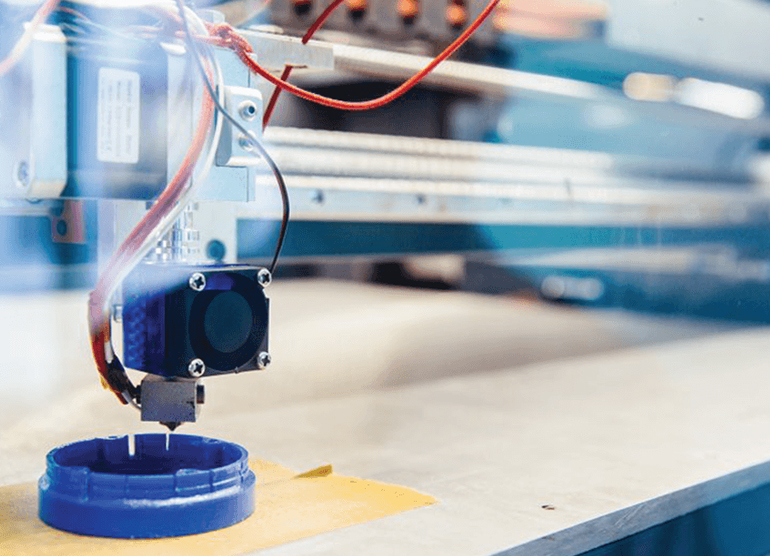
Blogs

3D printing advancements have proven that the technology is becoming faster, procedures are becoming more automated, and production volumes are increasing. 3D printing has already reached the stage where it provides considerable manufacturing value to businesses. The potential to dramatically lower manufacturing costs in all areas of manufacturing, from design to product development and production, is one aspect of this technology.
With 3D printing proving its worth at every level of the production process, we'll go through ways the technology can help organizations reduce expenses.
Development of a Product
One of the most common applications for 3D printing is product development or rapid prototyping. Prototyping with 3D printing can considerably cut the cost of producing new items for businesses. Because 3D printing uses digital CAD data, iterating on a prototype is as simple as changing the design. This means that companies may create countless iterations of a product considerably faster and at a lower cost than they could with traditional manufacturing processes.
Faster design iterations lead to a faster product development cycle because problems in the product can be fixed and improvements made early in the design stage, reducing the risk of serious mistakes.
Reduced Material Costs
Another reason to consider 3D printing as a manufacturing solution is to reduce raw material costs. The printing process drastically lowers material waste because the raw material is placed layer by layer and only where needed in 3D printing. In contrast to subtractive manufacturing methods, which often generate more material waste, 3D printing is resource-efficient, mainly when high-value materials are utilized.
3D printing is one of the few ways lightweight metal parts can be produced cost-effectively in industries like Aerospace and Automotive, where even one kilogram saved can result in substantial cost savings. Removing material from an item to lower its weight in subtractive manufacturing makes it more expensive. Cutting, drilling, and machining all demand additional labor and thus cost. The difficulty of building lightweight structures does not come at an additional cost with 3D printing. The lighter the part, the cheaper and faster the manufacturing process becomes.
New Design Possibilities
3D printing allows product designers and engineers to experiment with intricate shapes and geometries that would be impossible to achieve with any other approach. When it comes to part consolidation, designing for additive manufacturing can save money. Traditional manufacturing demands multiple components be manufactured and then combined to form the finished object, while 3D printing takes a different method.
A part made up of numerous independent components can be produced as a single, integrated part using the technique. As the part's performance improves, manufacturers can obtain significant cost savings by using part consolidation techniques including labor expenses associated with assembly work, decreased inventory costs, and lower maintenance costs.
Production of Low Volumes
Many times, the scale of production does not justify the investment in high-cost manufacturing tooling. As a result, traditional manufacturing techniques like injection moulding are often impractical for low-volume production. However, as 3D printing is production technology, it has opened up new possibilities for a more cost-effective approach to creating small batches of products. 3D printing becomes an excellent alternative for delivering parts in small numbers because it has no tooling or setup requirements.
Low Tooling Costs
3D printing production tools, such as jigs and fixtures, can significantly cut manufacturing costs. Jigs and fixtures are frequently outsourced to outside vendors, who CNC mill or hand weld and assemble them. 3D printing jigs and fixtures in-house can be a considerably faster and less expensive option.
Spare Parts Printed in 3D
Many companies keep a stock of spare parts that are infrequently used and have low demand, which can be costly. There is no need to hold inventory for such spare components with 3D printing. Manufacturers can use technology to make spare parts on-demand, reducing the number of parts in storage and lowering inventory holding costs.
OEMs and spare part suppliers are establishing localized AM facilities to 3D print spare parts closer to consumers as a result of distributed manufacturing. This results in faster and easier delivery, reducing logistics costs and eliminating supply-chain complications. 3D printing's precision and efficiency have made it a significant advantage for various industries, including Aerospace, Automotive, and Healthcare.
Innovae3D is a leading manufacturing company offering on-demand 3D Printing in Pune. Innovae3D provides high-resolution prototypes and complex production parts through more efficient, on-demand, lightweight components, and environmentally-friendly material. For the Best Metal 3D Printing Service in India, choose Innovae3D.
To explore more about Rapid Prototyping Services in India, Conformal Cooling Tooling, Prototype Parts Manufacturing, and how it saves time and money visit @ https://innovae3d.com/